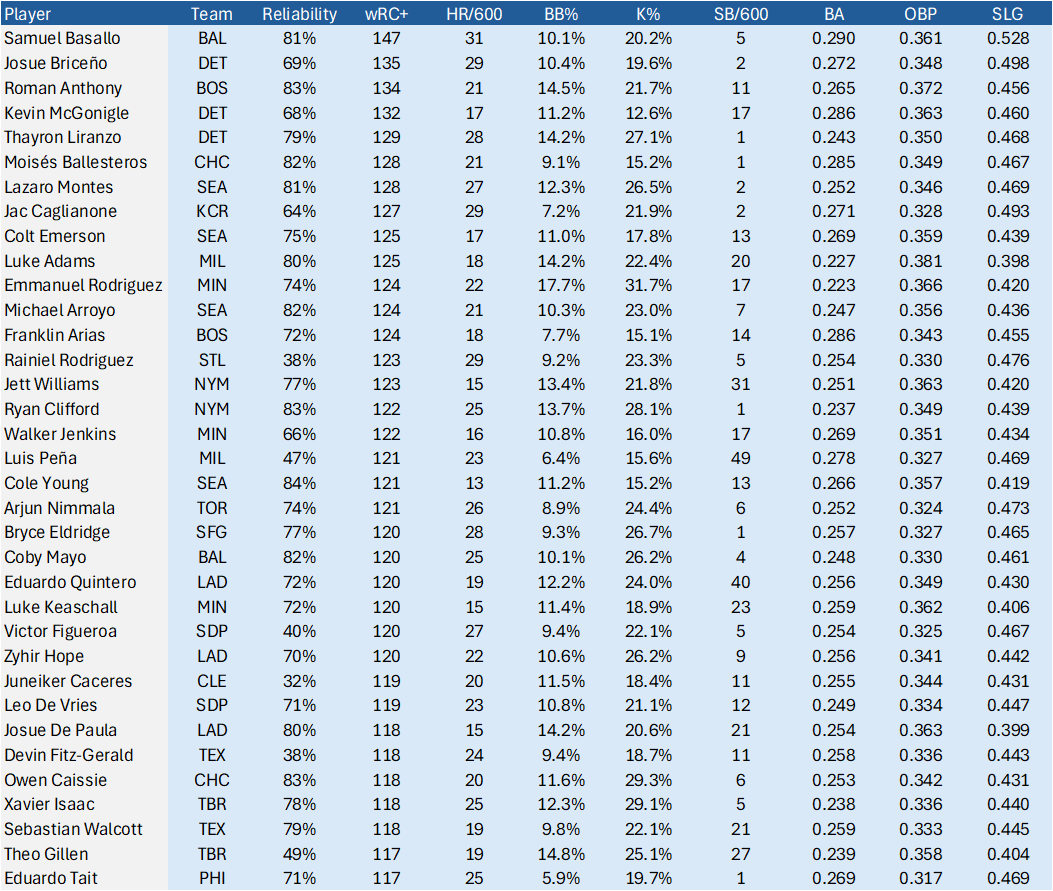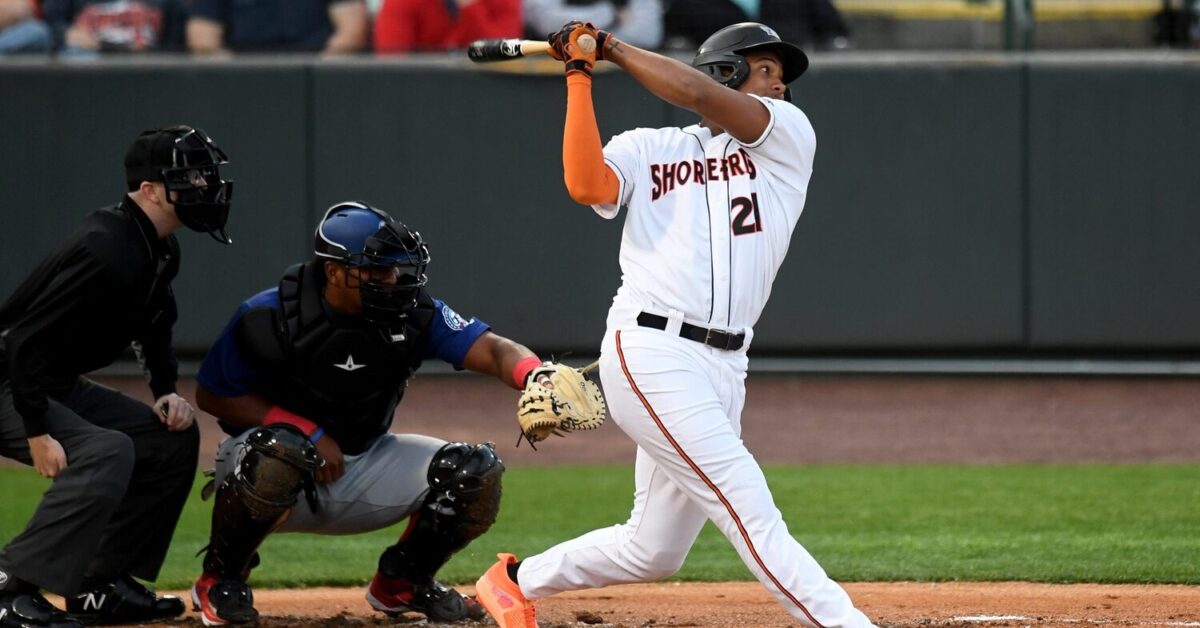Projections-Fueled Top 30 Hitting Prospects, Midseason 2025 Update
Now that almost 50% of the season is in the books, it’s a good time to check in on baseball’s top hitting prospects from a projections-based perspective. You can see the preseason list here and last year’s midseason list here. Those articles also feature more methodological detail if you want to read more about the projections process. Briefly, the projections capture prospect performance across the (non-DSL) minor and major leagues in recent years, making use of aging curves, major league equivalencies, league environment adjustments, park factors, regression, and more, to project peak (late-20s) prospect performance in the majors. They do not capture scouting, defense, or amateur performance. Starting this offseason, they also capture bat speed, which was made available for a decent handful of prospects this spring training.
Examining last year’s midseason top 30—led by Lazaro Montes, Junior Caminero, Samuel Basallo, Jackson Holliday, and Moisés Ballesteros—the top 20 have aged reasonably well so far, with no major disappointments yet. The last 10 features a mix of sleeper prospects that are now basically universally acclaimed—Kevin McGonigle, Josue Briceño, and Ben Rice, especially—but also some disappointments who have taken a step back this year—Samuel Zavala and Ralphy Velazquez stick out, in particular. These breakouts and disappointments did not make the updated FanGraphs 2024 Top 100. Nor did Lazaro Montes or Luke Keaschall, two players who landed among last year’s projections-fueled midseason top 15. Keaschall, McGonigle, and Briceño did make the 2025 Fangraphs Top 100, however. These cases exemplify how a projections-fueled list has the potential to help you pinpoint breakouts early—but also to lead you astray. Projections should be balanced against scouting reports to maximize your chances of success.
Without further ado, the top 30 hitting prospects by peak projected MLB wRC+ are ranked below. The peak projections capture data through the games of June 19th and assume a neutral MLB park in the 2024 MLB environment. Reliability represents the proportion of a player’s projection that comes from his own performance versus the proportion that is comprised of regression to the mean. For instance, regression comprises 19% of the weight in Samuel Basallo’s forecast. For convenience, I use the old 130 MLB at bat (AB) threshold to determine prospect eligibility.

Basallo was the second best hitting prospect per projections heading into the season. He has separated himself from the rest of the pack with a stellar 2025, and looks to be on the cusp of an MLB call up. Nick Kurtz just eclipsed 130 MLB AB, but he’s the only player who would have come close to Basallo, with a peak wRC+ projection of 139. Roman Anthony has held the top spot at several instances this year, but his slow start in the majors has dinged him slightly. Still, it’s important to note that projections can move quite quickly for prospects given they have a limited sample of data relative to MLB veterans. Kristian Campbell and Jasson Dominguez were not included as they eclipsed eligibility, but their projections are also down a bit after accounting for 2025 data. Both still maintain strong peak projections, at 123 and 124 wRC+, respectively.
The Tigers have the two biggest breakouts of 2025 so far in Kevin McGonigle and Josue Briceño. They are beloved by scouts and projections alike and, in my view, look like the strongest candidates to enter 2026 as baseball’s top prospect, after likely graduations from Basallo and Anthony. Thayron Liranzo, another Tigers prospect in the FanGraphs Top 100, continues to earn the admiration of the model. His projection is boosted a good amount by the inclusion of his 77.2 MPH spring training bat speed. This bat speed was compiled over only six swings, but bat speed is highly reliable even in small samples. From a fantasy perspective, it is understandable to be wary of catchers in one-catcher leagues. While Basallo and Briceño simply look too good at hitting to be rested as often as catchers usually are, Liranzo and Moisés Ballesteros could see their fantasy value held back somewhat by their position.
Luke Adams refuses to stop hitting as he climbs the minor league ladder. The projections don’t expect him to ever hit for average, but he looks like he will be a strong contributor in OBP leagues. Spring training did not provide us with any swing speed data for Sebastian Walcott. Given his exceptional scouting reports, I expect him to keep rising up the list as the sample size on him increases. Jac Caglianone has more than made up for an underwhelming 2024 debut at this point, with his peak projections now lining up with what scouts expected from him. He’s a good cautionary tale against putting too much weight into forecasts based on a small sample in a player’s debut year. If scouts aren’t worried about a mediocre debut, I would try not to worry about it too much. Like Liranzo, Caglianone also has spring training bat speed data available: his average swing speed was 77.8 MPH across nine swings this spring; it is at 77.6 MPH in the majors. Reliable, indeed!
Moving on to some of the lesser known names on the list: Juneiker Caceres has looked great in the Arizona Complex League, generating enthusiasm for underrated power at Baseball America; Rainiel Rodriguez has cooled a bit after his promotion to Class A, but his performance has nonetheless caught the attention of the industry; Victor Figueroa is too old and too good for Class A, but he has crushed baseballs this year, forcing analysts to take notice.


I’ve been trying to temper my excitement for Briceño, but this article isn’t helping.